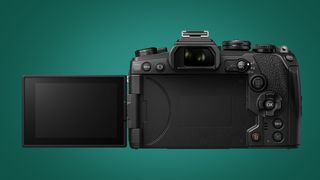Olympus E-M1 Mark III is a mirrorless powerhouse with a price tag to match
The heavily leaked mirrorless all-rounder is now official

Like snapping sports and wildlife? The new Olympus E-M1 Mark III is one of the most speedy, powerful mirrorless cameras we've seen for a while – and it comes with a pro-level price tag to match.
Like a mini version of the flagship E-M1X, the E-M1 Mark III is a Micro Four Thirds camera for professionals and keen amateurs who prize speed, shooting features and portability above all else.
If you want a more in-depth look at the camera, you can read our in-depth first impressions of the camera in our hands-on Olympus E-M1 Mark III review.
Four Thirds sensors like the one in this camera are smaller than their APS-C and full-frame equivalents, which can make them an acquired taste. But on the plus side, they do allow cameras like the E-M1 Mark III to squeeze in shooting features that would otherwise be impossible in a body this small.
One of those is a boosted in-body image stabilization (IBIS) system that claims to provide 7.5 stops of compensation, allowing handheld shooters to use slower shutter speeds to help keep their ISO low and preserve image quality.
The 20.4MP Live MOS sensor is sadly the same as its predecessor, but is paired with a new TruePic IX processor that powers some impressive AF and software skills, which we first saw in the E-M1X.
These include the 50MP Handheld High Res Shot, which helps landscape shooters get around the 20MP limitation of the sensor, and Face and Eye Priority autofocus, which stems from the 121-point Phase Detection AF.
Get daily insight, inspiration and deals in your inbox
Get the hottest deals available in your inbox plus news, reviews, opinion, analysis and more from the TechRadar team.
Other improvements on the Olympus E-M1 Mark II include a new 'multi selector' (otherwise known as a joystick) for quickly selecting AF points, and 'Live ND' for seeing the effects of the in-camera neutral density filter on your snaps in the viewfinder.
- Check out our in-depth Hands on: Olympus E-M1 Mark III review
- These are the best mirrorless cameras in the world right now
- Or read up the best travel cameras you can buy

Pro price tags
Aside from these new features, the E-M1 Mark III shares a lot of similarities with its predecessor, including a weather-sealed magnesium alloy body and its SSWF (Super Sonic Wave Filter Filter) tech, which should keep the sensor free of pesky dust particles.
The camera's 4K video has also been given a minor bump with the inclusion of the flat OM-Log400 profile, which lets more advanced shooters grade footage in post-production.
So does the Olympus E-M1 Mark III have any downsides? While it's shaping up to be a fine all-rounder, the main one is likely to be price. It'll be available to buy body-only from late February for $1,799.99 / £1,599.99 / AU$3,099, or in various kit lens combinations.
These kit bundles include one with the M.Zuiko Digital ED 12-40mm f/2.8 Pro lens for $2499.99 / £2,199.99 / AU$4,199 or another with the M.Zuiko Digital ED 12-100mm f/4.0 IS Pro lens for $2899.99 / £2,499.99 / AU$4,799.
These prices may sound quite hefty when you can pick up a full-frame Sony A7 III and Nikon Z6 for around the same asking price. On the other hand, the E-M1 Mark III is targeted at different photographers and Micro Four Thirds lenses are considerably smaller and more affordable than their full-frame equivalents.
If you don't need all of the E-M1 Mark III's new features, the E-M1 Mark II will remain on sale for a body-only price of £1,299.99 / AU$2,199 (around $1,680).
- Check out our in-depth Hands On Olympus E-M1 Mark III review

Mark is TechRadar's Senior news editor. Having worked in tech journalism for a ludicrous 17 years, Mark is now attempting to break the world record for the number of camera bags hoarded by one person. He was previously Cameras Editor at both TechRadar and Trusted Reviews, Acting editor on Stuff.tv, as well as Features editor and Reviews editor on Stuff magazine. As a freelancer, he's contributed to titles including The Sunday Times, FourFourTwo and Arena. And in a former life, he also won The Daily Telegraph's Young Sportswriter of the Year. But that was before he discovered the strange joys of getting up at 4am for a photo shoot in London's Square Mile.
